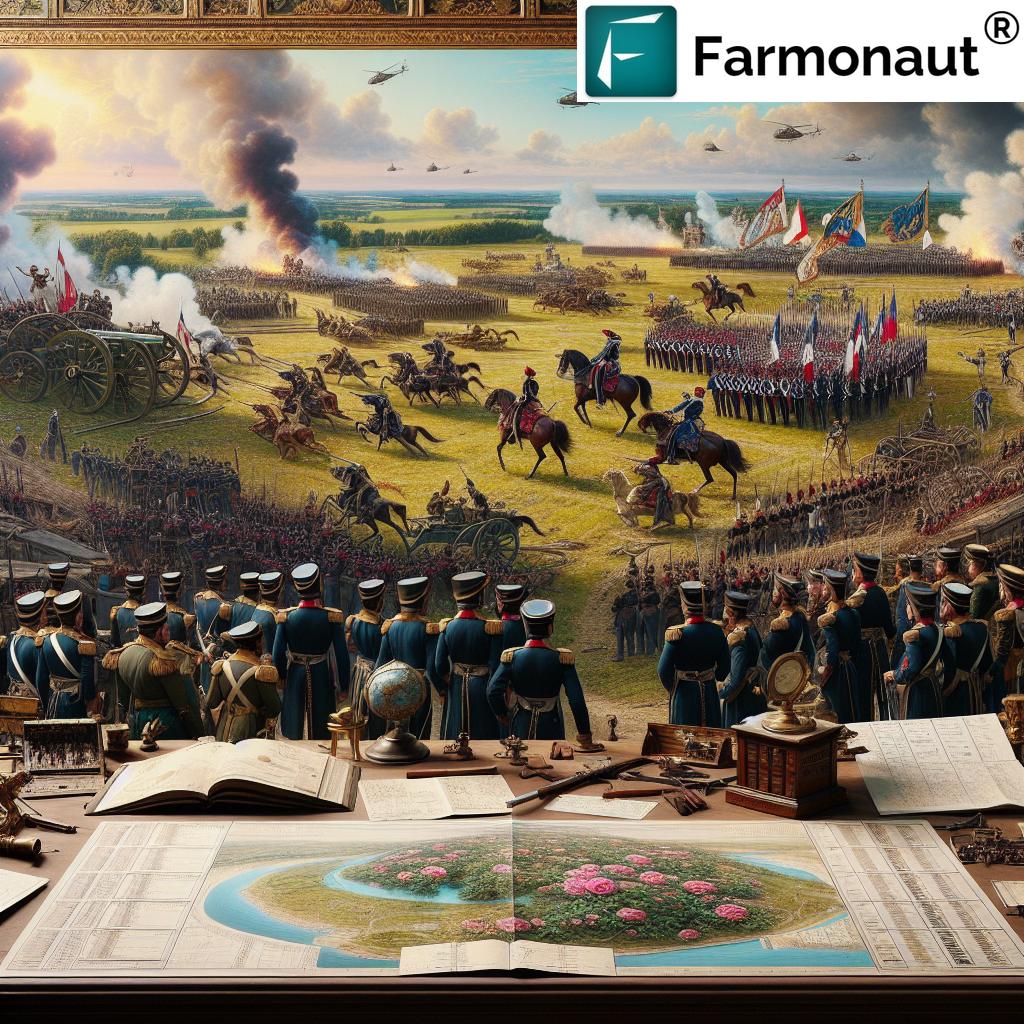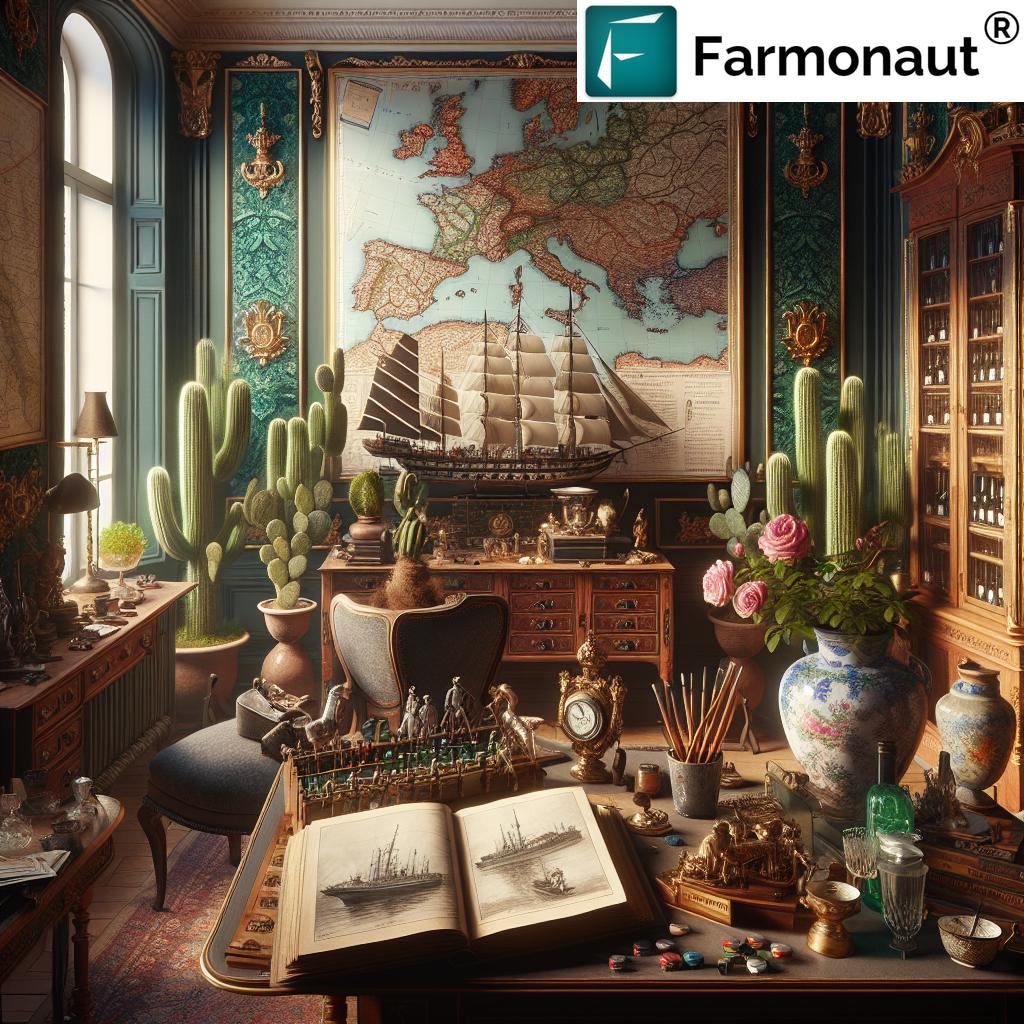Unveiling Military Genius: Famous Battles and Strategies in 19th Century European Warfare
“The Battle of Austerlitz in 1805 involved over 150,000 troops and resulted in nearly 27,000 casualties.”
As we delve into the fascinating world of 19th century European warfare, we find ourselves transported to an era of remarkable military strategies, famous battles, and the intricate interplay between war and culture. In this comprehensive exploration, we’ll uncover the tactical brilliance of commanders, the evolution of armed forces, and the unexpected connections between military campaigns and the natural world.
The Napoleonic Era: A Turning Point in Military History
The dawn of the 19th century ushered in a period of unprecedented military innovation, largely shaped by the ambitious campaigns of Napoleon Bonaparte. His strategic genius revolutionized warfare, influencing military tactics for generations to come.
The Battle of Austerlitz: Napoleon’s Masterpiece
On December 2, 1805, the fields near Austerlitz in modern-day Czech Republic witnessed one of the most decisive battles in European history. This engagement, often regarded as Napoleon’s greatest victory, exemplified the French emperor’s tactical brilliance and the effectiveness of his Grande Armée.

Napoleon’s strategy at Austerlitz involved a series of calculated moves:
- Feigning weakness to lure the Austro-Russian forces into a trap
- Deliberately weakening his right flank to entice enemy attack
- Launching a surprise assault on the enemy’s exposed flank
- Utilizing the “rising sun” to blind the enemy during the crucial moment of attack
The battle resulted in a decisive French victory, cementing Napoleon’s reputation as a military genius and reshaping the political landscape of Europe.
The Russian Campaign: Ambition Meets Its Match
In 1812, Napoleon embarked on his most ambitious and ultimately disastrous campaign – the invasion of Russia. This campaign highlights the importance of logistics and the dangers of overextension in military operations.
“Napoleon’s 1812 Russian Campaign began with 685,000 soldiers but ended with only 120,000 surviving the retreat.”
Key aspects of the Russian Campaign include:
- The massive scale of the French invasion force
- Russia’s scorched earth tactics and strategic retreat
- The brutal impact of the Russian winter on French troops
- The disastrous retreat from Moscow
The campaign’s failure marked the beginning of Napoleon’s decline and demonstrated the limitations of even the most formidable military machine when faced with environmental challenges and determined resistance.
Beyond the Battlefield: The Unexpected Connections
While military campaigns dominated much of 19th century European history, there were fascinating intersections between warfare, botany, and culture that often go unnoticed.
Josephine’s Rose Gardens: A Legacy of Beauty Amid Conflict
Amidst the turmoil of the Napoleonic Wars, Empress Josephine cultivated an extraordinary rose garden at Malmaison. This botanical treasure trove became a symbol of beauty and scientific pursuit in an era of conflict.
- Josephine’s passion for botany led to the collection of over 250 rose varieties
- Napoleon ordered his warship commanders to search captured vessels for plants to be sent to Malmaison
- The gardens became a center for botanical research and hybridization
This intersection of war and horticulture highlights the complex nature of 19th century European society, where scientific and cultural pursuits often coexisted with military ambitions.

The Deadly Beauty of Imperial Residences
The grandeur of 19th century imperial residences often concealed unexpected dangers. The use of arsenic-based pigments in wallpapers and fabrics created health hazards for residents and staff alike.
- Copper arsenite, used in vibrant green pigments, was particularly popular in imperial decorations
- Napoleon’s residence on St. Helena may have contained arsenic in the wallpaper, contributing to his declining health
- The widespread use of arsenic in everyday items reflected the era’s limited understanding of chemical hazards
This intersection of luxury and danger provides a unique perspective on the living conditions of Europe’s elite during this tumultuous period.
Military Innovations and Their Lasting Impact
The 19th century saw significant advancements in military technology and organization, many of which continue to influence modern warfare.
The Prussian Military System: A Model of Efficiency
Prussia’s military reforms in the early 19th century created a highly efficient and professional armed force that would later serve as a model for other European nations.
- Introduction of a General Staff system for strategic planning
- Emphasis on education and merit-based promotions
- Development of a reservist system to maintain a large, trained force
These innovations allowed Prussia to punch above its weight in European conflicts and ultimately led to the unification of Germany under Prussian leadership.
Technological Advancements in Warfare
The 19th century witnessed rapid technological progress that transformed the nature of armed conflict:
- Improved firearms, including rifled muskets and breech-loading rifles
- Advancements in artillery, such as rifled cannon and explosive shells
- The introduction of steam-powered warships and ironclad vessels
- Early developments in military telegraphy and balloon reconnaissance
These technological innovations had profound effects on military tactics and strategy, leading to increased lethality on the battlefield and changing the nature of naval warfare.
The Interplay of Warfare and Agriculture
While battles raged across Europe, agricultural practices continued to evolve, often influenced by the demands of warfare and the movement of troops.
Military Campaigns and Botanical Exchange
Napoleon’s campaigns, while primarily focused on conquest, inadvertently facilitated the exchange of plant species across Europe and beyond:
- Troops introduced new crops to occupied territories
- Botanists accompanying military expeditions collected and cataloged new plant species
- The movement of armies led to the unintentional spread of weeds and invasive plants
This botanical exchange had lasting impacts on European agriculture and ecosystems.
The Impact of War on Farming Practices
The constant state of warfare in 19th century Europe had significant effects on agricultural production:
- Shortage of labor as men were conscripted into armies
- Destruction of crops and farmland during military campaigns
- Innovation in farming techniques to meet increased demand for food
These challenges spurred agricultural innovations and often led to the adoption of new farming methods and technologies.
The Legacy of 19th Century Warfare
The military strategies and famous battles of 19th century Europe left an indelible mark on history, shaping not only the political landscape but also influencing art, literature, and popular culture.
Cultural Impact of Napoleonic Wars
The Napoleonic era inspired countless works of art and literature:
- Tolstoy’s “War and Peace” provides a sweeping narrative of the Russian Campaign
- Paintings by artists like Gros and Gericault captured the drama of Napoleonic battles
- Military memoirs and histories became popular genres, shaping public perception of the era
These cultural productions continue to influence our understanding of this pivotal period in European history.
Long-term Effects on Military Thought
The strategies and tactics developed during the 19th century had lasting effects on military doctrine:
- Napoleon’s emphasis on mobility and concentration of force influenced military thinking well into the 20th century
- The Prussian General Staff system became a model for modern military organizations
- Lessons learned from the failures of the Russian Campaign informed future logistical planning
Many of these concepts continue to be studied and applied in military academies around the world.
Comparative Analysis of 19th Century European Battles
| Battle Name | Year | Key Commanders | Military Strategies Employed | Outcome and Significance | Estimated Troop Numbers |
|---|---|---|---|---|---|
| Austerlitz | 1805 | Napoleon Bonaparte vs. Alexander I and Francis II | Feigned retreat, flank attack, use of terrain | Decisive French victory, established French dominance in Europe | 73,000 French vs. 85,000 Allies |
| Borodino | 1812 | Napoleon Bonaparte vs. Mikhail Kutuzov | Frontal assault, artillery bombardment | Pyrrhic French victory, opened way to Moscow but at great cost | 130,000 French vs. 120,000 Russians |
| Leipzig | 1813 | Napoleon Bonaparte vs. Coalition forces | Defense in depth, use of interior lines | Coalition victory, marked Napoleon’s decline | 190,000 French vs. 350,000 Coalition |
| Waterloo | 1815 | Napoleon Bonaparte vs. Duke of Wellington and Gebhard von Blücher | Divide and conquer attempt, cavalry charges | Decisive Allied victory, end of Napoleonic era | 72,000 French vs. 118,000 Allied |
The Role of Technology in 19th Century Warfare
Technological advancements played a crucial role in shaping military strategies and the outcomes of battles during this period. From improved weaponry to innovative communication systems, these developments had far-reaching impacts on the conduct of war.
Advancements in Firearms and Artillery
- Introduction of rifled muskets increased accuracy and range
- Development of breech-loading rifles increased rate of fire
- Improvements in artillery, including exploding shells and rifled barrels
These advancements led to changes in tactical doctrine, with a greater emphasis on dispersed formations and the use of cover.
Transportation and Logistics
- Development of railways revolutionized troop and supply movement
- Steamships improved naval logistics and power projection
- Improved road networks facilitated faster marches and supply lines
These innovations allowed for larger armies to be sustained in the field for longer periods, dramatically changing the scale and duration of military campaigns.
The Evolution of Military Leadership in the 19th Century
The 19th century saw significant changes in the nature of military leadership, influenced by both technological advancements and changing political landscapes.
From Aristocratic Officers to Professional Commanders
- Shift away from purchasing officer commissions towards merit-based promotions
- Establishment of military academies to provide formal education for officers
- Increased emphasis on strategic and tactical studies
These changes led to a more professional and competent officer corps, capable of handling the complexities of modern warfare.
The Rise of the General Staff System
- Prussian innovation that created a body of professional military planners
- Allowed for more coordinated and complex military operations
- Emphasis on wargaming and scenario planning
The General Staff system proved highly effective and was widely adopted by other European powers in the latter half of the century.
The Intersection of Military Campaigns and Scientific Exploration
While primarily focused on conquest and political objectives, 19th century military campaigns often had unexpected scientific benefits.
Napoleon’s Egyptian Campaign: A Scientific Expedition
- Inclusion of scientists and scholars in the military expedition
- Discovery of the Rosetta Stone, key to deciphering Egyptian hieroglyphs
- Comprehensive survey and documentation of Egyptian antiquities
This campaign exemplified how military endeavors could contribute to scientific knowledge and cultural understanding.
Military Surveying and Cartography
- Development of more accurate maps for military purposes
- Advancements in surveying techniques and equipment
- Contribution to geographical knowledge of unexplored regions
These military-driven advancements in cartography had lasting impacts on geography and exploration.
The Economic Impact of 19th Century Warfare
The constant state of warfare in 19th century Europe had profound effects on economic systems and industrial development.
The Rise of War Industries
- Increased demand for weapons and military equipment spurred industrial growth
- Development of new manufacturing techniques to meet military needs
- Growth of industries such as steel production and chemical manufacturing
These war-driven industrial advancements had lasting impacts on European economies and technological progress.
The Financial Burden of Warfare
- Increased taxation to fund military campaigns
- Development of more sophisticated financial systems to manage war debts
- Economic disruptions caused by blockades and trade restrictions
The financial strategies developed to fund warfare had long-term effects on national economies and international finance.
The Legacy of 19th Century Warfare in Modern Military Thought
Many of the strategies and concepts developed during this period continue to influence military thinking today.
Enduring Strategic Concepts
- The importance of mobility and concentration of force
- The role of intelligence and reconnaissance in military planning
- The concept of total war and national mobilization
These ideas, refined through the crucible of 19th century conflicts, remain relevant in modern military doctrine.
Lessons in Leadership and Command
- The importance of adaptability and quick decision-making
- The value of strategic planning and scenario analysis
- The role of charismatic leadership in motivating troops
The leadership styles and command structures that emerged during this period continue to be studied and emulated in military academies worldwide.
Conclusion: The Lasting Impact of 19th Century European Warfare
As we’ve explored in this comprehensive overview, the military strategies and famous battles of 19th century Europe had far-reaching impacts that extended well beyond the battlefield. From revolutionary tactics and technological innovations to unexpected intersections with botany and culture, this era shaped the course of history in profound ways.
The legacy of these conflicts continues to influence military thought, political structures, and even agricultural practices to this day. By understanding the complexities and nuances of this pivotal period, we gain valuable insights into the forces that shaped modern Europe and the world at large.
As we reflect on the triumphs and tragedies of 19th century warfare, we’re reminded of the enduring human capacity for both destructive conflict and remarkable innovation. The lessons learned from this era remain relevant as we navigate the complex geopolitical landscape of the 21st century.
FAQ Section
Q: What was the most significant battle of the 19th century in Europe?
A: While many battles were significant, the Battle of Waterloo in 1815 is often considered the most impactful, as it marked the final defeat of Napoleon Bonaparte and ended the Napoleonic era.
Q: How did Napoleon’s military strategies differ from those of his contemporaries?
A: Napoleon emphasized mobility, concentration of force, and decisive battle. He also innovated in areas such as artillery use and corps-level organization, allowing for more flexible and responsive armies.
Q: What role did technology play in 19th century warfare?
A: Technological advancements, including improved firearms, artillery, and transportation (especially railways), dramatically changed the nature of warfare, allowing for larger armies, longer campaigns, and increased lethality on the battlefield.
Q: How did 19th century warfare impact civilian populations?
A: The concept of “total war” emerged, leading to greater civilian involvement and impact. Populations faced increased taxation, conscription, and sometimes direct effects of battles and occupations.
Q: What lasting impacts did 19th century European warfare have on military organization?
A: Key developments included the professionalization of officer corps, the establishment of general staff systems, and the creation of more sophisticated logistics and planning processes, many of which are still used in modern militaries.
Earn With Farmonaut: Affiliate Program
Earn 20% recurring commission with Farmonaut’s affiliate program by sharing your promo code and helping farmers save 10%. Onboard 10 Elite farmers monthly to earn a minimum of $148,000 annually—start now and grow your income!
For those interested in modern agricultural technology and precision farming, consider exploring Farmonaut’s innovative solutions:
For developers interested in integrating agricultural data into their applications, check out Farmonaut’s API and API Developer Docs.




















